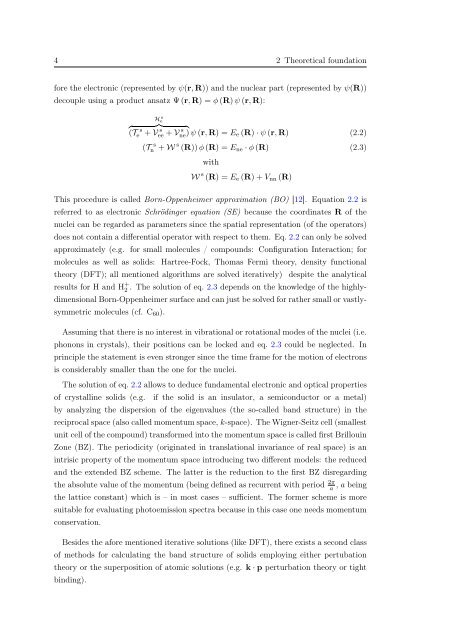Diploma - Max Planck Institute for Solid State Research
Diploma - Max Planck Institute for Solid State Research
Diploma - Max Planck Institute for Solid State Research
You also want an ePaper? Increase the reach of your titles
YUMPU automatically turns print PDFs into web optimized ePapers that Google loves.
4 2 Theoretical foundation<br />
<strong>for</strong>e the electronic (represented by ψ(r, R)) and the nuclear part (represented by ψ(R))<br />
decouple using a product ansatz Ψ (r, R) = φ (R) ψ (r, R):<br />
H s e<br />
{ }} {<br />
(Te<br />
s + Vee s + Vne) s ψ (r, R) = E e (R) · ψ (r, R) (2.2)<br />
(T s<br />
n + W s (R)) φ (R) = E ne · φ (R) (2.3)<br />
with<br />
W s (R) = E e (R) + V nn (R)<br />
This procedure is called Born-Oppenheimer approximation (BO) [12]. Equation 2.2 is<br />
referred to as electronic Schrödinger equation (SE) because the coordinates R of the<br />
nuclei can be regarded as parameters since the spatial representation (of the operators)<br />
does not contain a differential operator with respect to them. Eq. 2.2 can only be solved<br />
approximately (e.g. <strong>for</strong> small molecules / compounds: Configuration Interaction; <strong>for</strong><br />
molecules as well as solids: Hartree-Fock, Thomas Fermi theory, density functional<br />
theory (DFT); all mentioned algorithms are solved iteratively) despite the analytical<br />
results <strong>for</strong> H and H + 2 . The solution of eq. 2.3 depends on the knowledge of the highlydimensional<br />
Born-Oppenheimer surface and can just be solved <strong>for</strong> rather small or vastlysymmetric<br />
molecules (cf. C 60 ).<br />
Assuming that there is no interest in vibrational or rotational modes of the nuclei (i.e.<br />
phonons in crystals), their positions can be locked and eq. 2.3 could be neglected. In<br />
principle the statement is even stronger since the time frame <strong>for</strong> the motion of electrons<br />
is considerably smaller than the one <strong>for</strong> the nuclei.<br />
The solution of eq. 2.2 allows to deduce fundamental electronic and optical properties<br />
of crystalline solids (e.g. if the solid is an insulator, a semiconductor or a metal)<br />
by analyzing the dispersion of the eigenvalues (the so-called band structure) in the<br />
reciprocal space (also called momentum space, k-space). The Wigner-Seitz cell (smallest<br />
unit cell of the compound) trans<strong>for</strong>med into the momentum space is called first Brillouin<br />
Zone (BZ). The periodicity (originated in translational invariance of real space) is an<br />
intrisic property of the momentum space introducing two different models: the reduced<br />
and the extended BZ scheme. The latter is the reduction to the first BZ disregarding<br />
the absolute value of the momentum (being defined as recurrent with period 2π a , a being<br />
the lattice constant) which is – in most cases – sufficient. The <strong>for</strong>mer scheme is more<br />
suitable <strong>for</strong> evaluating photoemission spectra because in this case one needs momentum<br />
conservation.<br />
Besides the a<strong>for</strong>e mentioned iterative solutions (like DFT), there exists a second class<br />
of methods <strong>for</strong> calculating the band structure of solids employing either pertubation<br />
theory or the superposition of atomic solutions (e.g. k · p perturbation theory or tight<br />
binding).
















